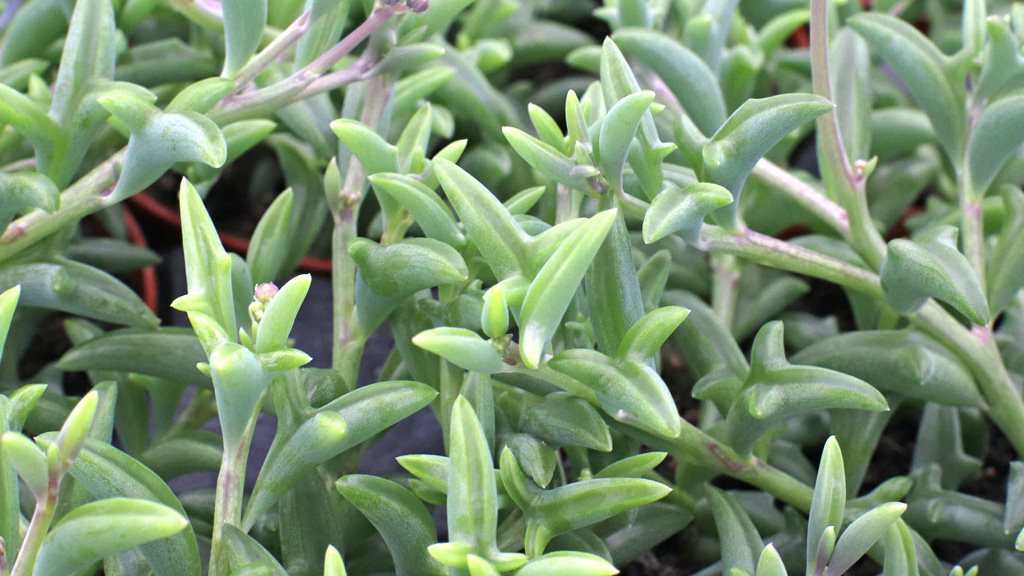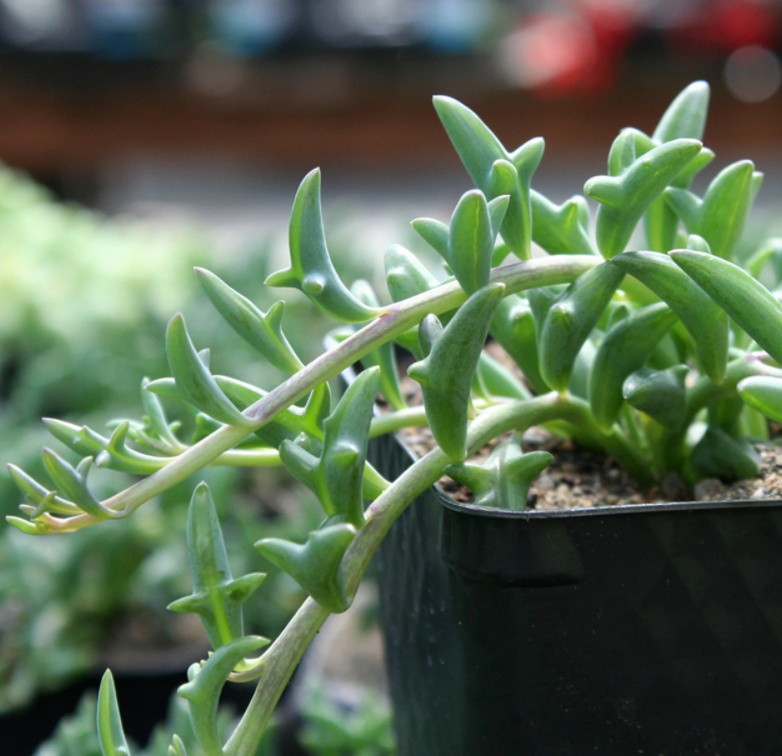Dolphin Plant Care – How To Grow And Care For String Of Dolphins
Of the many succulents out there, the dolphin plant is perhaps the most fun to have in your garden. Just like its marine life namesake, this succulent is pleasing to the eye, easy to care for, and quite entertaining. And it’s easy to see why people are falling in love with the dolphin plant. Far from being just another succulent, this is a plant with personality. It’s playful, dynamic in shape, and looks like it’s going to jump into the water. So what’s there not to like?
Perhaps the only thing you won’t like about this plant is its toxicity. We’ll talk about that in detail later along with how to take precautions to keep yourself and your family safe. But other than that, this succulent is pure joy wherever it grows. If you want to know how to grow and maintain this jolly succulent, this article covers all the bases.
Dolphin Plant at a Glance
Say what you like about succulents, but if a plant is called a string of dolphins (Curio peregrinus), you’ll have a hard time not loving it. The thing about the dolphin plant is that it lives up to its reputation. As a native of Southwest Africa, this succulent will look as lively in a planter as it will in a hanging basket. In fact, due to its toxicity, a hanging basket is the ideal option here. It keeps it away from the reach of inquisitive cats and precocious dogs.
The dolphin plant is known by many other names. In some places, people fondly call it the dolphin necklace while others know it simply as the flying dolphins of the string of dolphins. But whatever you like to call it, there’s no denying the ornamental value of this succulent that grows well both indoors and outdoors.
The mature plant reaches about 6 inches tall, although the vines continue to grow to reach 36 inches. The plump leaves store water and have this unique shape of leaping dolphins. They’re sleek and look in every way like carved dolphins. Combine them with a string of pearls plant in the same hanging basket to create a dynamic atmosphere in the room. But even on its own, this succulent is a great addition to any setting.
In the spring, small white flowers bloom to increase the dramatic effect of the leaping leaves. They are in fact composite of tiny clusters of flowers blooming together. They have a nice scent that reminds one of cinnamon. The flowers don’t stay in bloom for long.
How to Grow Dolphin Plant
As is the case with many succulents, the dolphin plant is easy to grow from seeds. Just make sure you get your seeds from a good source to avoid introducing invasive plants to your garden from contaminated seeds. You can also grow it from a cutting which is usually faster. Here we cover both starting the succulent from seeds as well as from a cutting.
Starting Dolphin Plants from Seeds
Once you have the seeds, the whole process is simple and straightforward.
- Give your seeds the water test to make sure they are good. Drop them in a bowl full of water and wait for them to sink. Skim the floating seeds off and discard them.
- Dolphin plant seeds are not easy to germinate. So first you need to soak them in warm water with a temperature around 100 degrees Fahrenheit. Keep it there overnight.
- The next day, drain the water and fill the bowl with cold water. Keep the seeds soaked for one day.
- Fill a container with a general-purpose potting mix. Water it to get it moist.
- Spread the seeds on the top of the soil and cover them with a thin layer of soil. Don’t pack them in.
- Cover the container with a plastic sheet and make holes in the sheet for aeration.
- Keep watering the container whenever the soil gets dry.
- After about 3 weeks the seeds will germinate. Sometimes germination might take a few months depending on how fresh the seeds are.
- When the seedlings are a few inches high, thin them out keeping only the healthy seedlings.
- Once the plant has two sets of leaves, you can move it to its own hanging basket or its permanent place in the garden.
Growing Strings of Dolphins from a Cutting
Because it’s rare, sometimes it’s hard to find a mature plant to get a cutting. However, this is the recommended way to grow the dolphin plant considering how long it takes for the seeds to germinate. Just keep in mind that both the leaves and stems will grow roots. However, the planted leaves will not develop into a full plant nor will they grow new leaves. So always use stem cuttings, not leaves to start a new dolphin plant.
- Prepare a container or a hanging basket and fill it with a suitable potting mix. Make sure the container has plenty of drainage holes at the bottom.
- Keep the cutting in a warm and dry place for a couple of days until the cutting heals.
- When the cutting is calloused, you either lay it on its side on top of the soil or plant it in the container.
- Roots usually shoot out of any points of the cutting that are in contact with the soil. So either way, you plant it, it will grow.
- Water the soil and keep it moist until the roots establish.
Dolphin Plant Care
While the dolphin plant usually requires little care, light is a tricky part when maintaining this succulent. It can tolerate fluctuating temperatures, drought, and even poor soil. But when it comes to light, it demands plenty of it.
Soil
Apart from well-drained, the soil has to be both arid and neutral for the dolphin plant to thrive. You can always get a good succulent potting mix for it. Absent that, you can make your own homemade potting mix. Use two portions of soil, one portion of coarse sand, and one portion of perlite. Mix well and check the pH level. If the soil is below 6.6 or above 7.5 then keep adding sand and perlite to adjust its acidity. To check the soil drainage, make a two-inch hole in the container and fill it with water. If the soil takes more than a few seconds to absorb all the water, then it’s poorly drained. Add more perlite and sand until you have the right texture.
Light
That’s where it gets complicated. The dolphin plant loves plenty of sunlight. However, if you grow it outdoors where the sun shines bright, there’s a risk it will get sunburnt. If you grow it indoors in a hanging basket, it will not thrive unless you place it near a window that gets at least 6 hours of sun every single day. So that’s the dilemma. How do you ensure this succulent gets adequate sun without damaging its leaping dolphins? The answer lies in filtered light and partial shade. If you grow it in the garden, pick a spot that gets dappled light, preferably in the shade of a tree. If you plant it in a hanging basket, place it near a window and draw a thin or lacy curtain between the plant and the sun.
Water
Unlike other plants that make you jump into hoops to get its water needs just right, the flying dolphins have simple water requirements. The plump leaves that look like frolicking dolphins are in fact water storage units to help the plant brave the drought. During the summer months, you need to let the soil dry out before you water the plant. On average, you should water it once a week. But once the weather changes, you won’t need to water this drought-tolerant succulent that much. In the fall and winter, cut back watering to about once a month. Keep in mind that even though the leaves are choke-full of water, the roots don’t like wet soil. Overwatering leads to root rot.
Fertilizer
The dolphin plant doesn’t require much fertilizing. In fact, in the right soil, it could do without fertilizer altogether. If you want to encourage the plant to bloom and spread its cinnamon-like fragrance, you could apply mild organic fertilizer such as rabbit manure tea or worm compost in moderation. Don’t use chemical fertilizers since they could interfere with the leaf growth and change its shape. Opt for low-nitrogen slow-release fertilizers and apply them once a year in the early spring.
Pests and Diseases
Since the leaves of the dolphin plant contain water, thirsty insects make this succulent their home. Aphids, spider mites, scale, and mealybugs all feed on the leaves and drain them of their precious sap. You can get rid of these pests the usual way. Use neem oil or soak a swab in rubbing alcohol. Give the leaves and vines a good rub to smother the pests and get rid of them.
As for diseases, you won’t have to worry about fungal infections or bacterial diseases. The hardy succulent is mostly disease-resistant. As long as you keep the soil dry and don’t overwater it, you won’t have a problem with root rot.
Dolphin Plant Toxicity
For all its beauty, the dolphin plant is highly toxic for pets and mildly poisonous for children. So you will need to take precautions to keep the dangling vines out of reach. When watering, pruning, or touching the plant. Always wear protective gear and avoid getting the vines or the sap on your skin.
Both dogs and cats will display strong symptoms if they ingest the leaves or stems of the plant. The symptoms include nausea and vomiting, drooling, dry mouth, diarrhea, and, in severe cases, liver failure. Children or toddlers who ingest the plant would have mild symptoms ranging from rash and skin irritation to itchiness and abdominal pain. You should seek medical help immediately in cases of dolphin plant poisoning.


Thankyou for all the useful information. I found your site the most helpful of all sources I have used in looking up information on plants I am trying to grow.